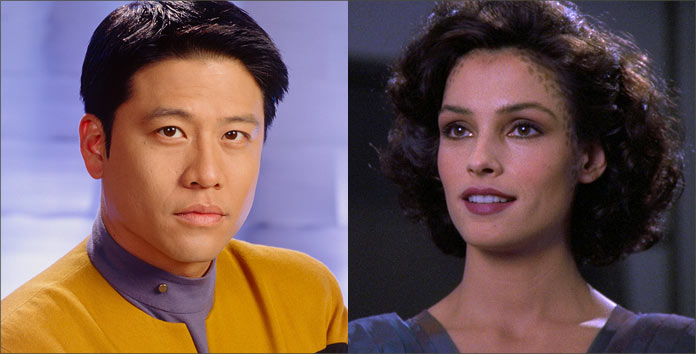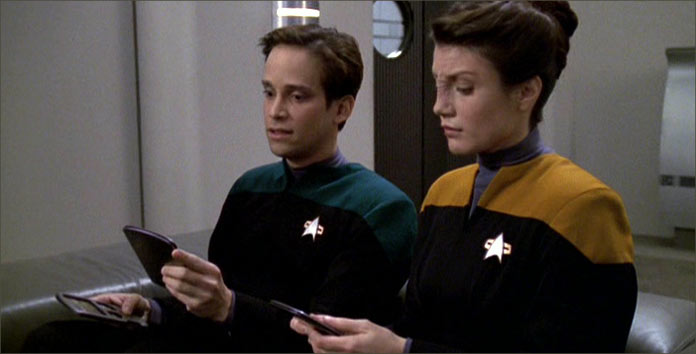As the Federation Starshp Voyager continues to lead the Full Circle Fleet in its exploration of the Delta Quadrant, Admiral Kathryn Janeway remains concerned about the Krenim Imperium and its ability to rewrite time to suit its whims.
At Captain Chakotay’s suggestion, however, she orders the fleet to focus its attention on a unique planet in a binary system, where a new element has been discovered.
Several biospheres exist on this otherwise uninhabitable world, each containing different atmospheres and features that argue other sentient beings once resided on the surface.
Janeway hopes that digging into an old-fashioned scientific mystery will lift the crews’ morale, but she soon realizes that the secrets buried on this world may be part of a much larger puzzle — one that points to the existence of a species whose power to reshape the galaxy might dwarf that of the Krenim…
After two years, author Kirsten Beyer returns to the 24th century with the release of her latest Star Trek: Voyager novel, Architects of Infinity.
The Star Trek: Discovery staff writer, who cut her teeth in the Star Trek universe writing some of the best Voyager books out there, delivers the ninth book in her run on the Voyager relaunch, telling the stories of what happened after Voyager left, and subsequently returned to, the Delta Quadrant.
Though this book was delayed in its release by nearly a year due to Beyer’s responsibilities on Discovery, in my opinion it was well worth the wait. Following on from 2016’s A Pocket Full of Lies, Architects of Infinity gives us a quintessential Star Trek story – a strange new world and an ancient civilization, layered with a rich character drama that advances the characters’ arcs in satisfying ways.
Architects of Infinity is exactly the kind of story that Star Trek is uniquely suited for – a classic tale of exploration that illuminates the wonder of scientific discovery. While it does not obviously advance some of the major storylines from the previous book, particularly as it relates to Voyager’s reintroduction to the Krenim, it does give us a lot to chew on – and a shocking cliffhanger!
Beyer has balanced her stories between those that return to familiar aliens or settings from the Voyager TV run with new concepts, and this book leans more towards the latter than the former. The main plot line for the book around the exploration of a mysterious planet in a binary star system where an ancient civilization has established a set of biodomes on the surface is a compelling one.
As the crews of the Full Circle fleet investigate, you really get that sense of wonder and desire for scientific discovery that Starfleet is meant to invoke. It’s an idea that the franchise has returned to too infrequently in recent years as – both on screen and in tie-in media – it has become more interested in action adventure tales. And while this book certainly is not without its action or adventure, it’s refreshing that the story revolves around a scientific challenge that the crew chooses, rather than simply needs, to solve.
One of the other triumphs of Beyer’s novels — and Architects of Infinity is no exception here — has been her ability to use the book format, and the need not to worry about budgets and production realities, to show aliens that are far more alien or depict scenes that are far grander than anything that could accomplished on television. Even a show with a budget the size of Star Trek: Discovery’s would probably struggle to make some of the things in these books a reality on screen.
In addition, Architects of Infinity is a stark reminder of the importance of gender diversity in Star Trek storytelling. This book explores a number of themes – particularly around consent and choice – that a male author would likely shy away from. These are important issues, and they’re ripe for exploration through Star Trek’s form of science fiction social commentary that the franchise has long been hailed for.

There are moral dilemmas around choice and consent baked into a number of character arcs, including Harry Kim, his relationship with the novel-original character Nancy Conlon, and their unborn daughter.
It also extends further with Beyer’s exploration of Ensign Gwyn, whose Kriosian heritage is explored in more detail and builds off The Next Generation episode “The Perfect Mate.” Beyer dives into the consent issues surrounding that culture and their empathic metamorphs, which were looked at in The Next Generation with the perspective of the day but were ripe for another look by modern standards.
Though the overall stable of Star Trek authors has shrunk over time, in addition to Beyer the only other women writing Star Trek fiction in recent years have been Una McCormack and Paula Block. Assuming the Star Trek novel line eventually resuscitates I hope the editors will consider finding additional women to add to their roster of regular writers, as the female perspective provides new angles for stories and directions for characters that only enriches the experience for all.
Beyer is a master at developing original characters and integrating them with the main crew, not least my favorite original character from Star Trek novels, the Voyager counselor Hugh Cambridge. While there is plenty of focus on the main characters, including furthering the Janeway/Chakotay relationship and the Paris/Torres family, this book has more of a “Lower Decks” feel to it. That famous season seven episode of The Next Generation showed the perspective of junior officers aboard the Enterprise-D, and several of the original characters Beyer has created for her novels take a step forward in this story.

In addition, Beyer explores the challenges that many of these characters face integrating with the Voyager clique – the group of characters that we know and love who made it through the Delta Quadrant together. While the old crew trusts each other implicitly, almost to the point of recklessness, the book explores how that impacts crew members who have joined since Voyager returned to the Alpha Quadrant and the lengths they take to get recognized and become part of the “family.”
In some of the books set after the series end, the integration of original characters with the TV characters is not always successful, but not so here. I am just as invested in Cambridge, Dr. Sharak, Captain Farkas, Doctor Sal, and Commander O’Donnell as I am in Janeway, Chakotay, Paris, and Torres.
In conclusion, if you like traditional Star Trek stories that encapsulate the “strange worlds and new civilizations” and “to boldly go where no one has gone before”” of the Star Trek mantra, I think you’ll get a big kick out of this book. And if you’re a Discovery fan looking to check our Beyer’s work – I probably wouldn’t start here because it’s like starting a show midway through a season, but I would definitely encourage you to revisit the earlier books in the series.

There has been some speculation online that Architects of Infinity will be the last Voyager novel, but as Beyer confirmed last year, she’s still contracted for one more tale — To Lose the Earth — that was commissioned prior to the expiration of Pocket Books’ license and can still be published. And given the epilogue to this book it is clear that Beyer did not write this to be the final in the series, it certainly seems we still have that to look forward to.
However, I would be remiss not to acknowledge that, with the exception of June’s Discovery novel, Fear Itself by James Swallow, there are no Star Trek novels from Pocket Books on the schedule for the foreseeable future.
Even though we continue to anticipate the renewal of the Star Trek novel license by Simon & Schuster and the resumption of publication, it is a bittersweet and frustrating that there are no 24th century novels from Pocket Books on the docket to look forward to.
If anyone reading is in a position to do anything about hurrying up the resolution of whatever issues have impeded the announcement of new Star Trek novels, please make it happen!
![]()
If you liked Architects of Infinity, you should check out:
- Full Circle by Kirsten Beyer: The first Star Trek: Voyager novel of Kirsten Beyer’s arc follows the lead up to the decision to return to the Delta Quadrant with the Full Circle fleet. This series hit the ground running in the best way, with the greatest Voyager novel that had been published in years up to that point.
- The Eternal Tide by Kirsten Beyer: The culmination of the first arc of Beyer’s Voyager series, The Eternal Tide is the story of the resurrection of Admiral Kathryn Janeway since her death in the Peter David novel Before Dishonor several years earlier.
- A Pocket Full of Lies by Kirsten Beyer: The previous novel in the series ties together a number of episodes of the series that dealt with time travel in a fun way, revisiting “Year of Hell” and “Shattered” and spinning off a new tale. Honestly, this is my favorite book of the series to date.

